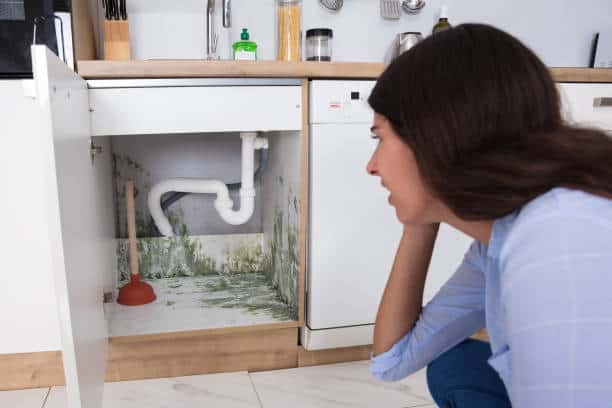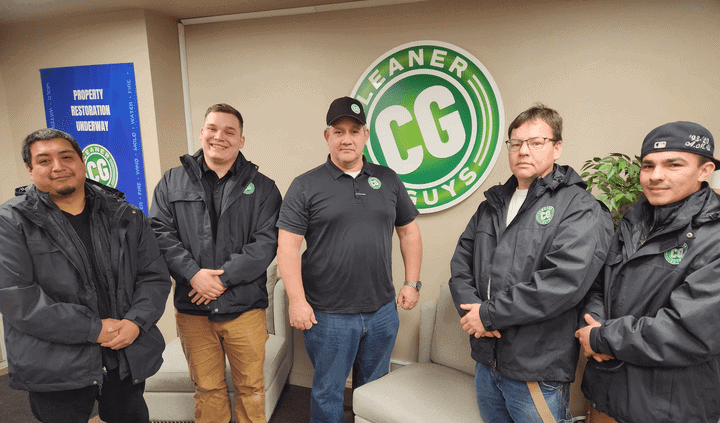Whether you’ve already touched mold with your bare hands, or you’ve spotted some mold and are wondering if it’s okay to touch it, this question comes up a lot. Here at Cleaner Guys, our mold experts get asked questions like this every day, because our neighbors and clients know we’re a trustworthy source of knowledge on all things mold! So today, we’re going to answer the question once and for all: “What happens if you touch mold with bare hands?”
We’ll cover not only this question, but several others relevant to it, such as “What do I do if I find mold in my home?”, “Can mold make you sick?”, and “Can I clean mold myself?” Read on!
Table of Contents
- What Happens If You Touch Mold With Bare Hands?
- What are Signs of Mold Sickness?
- There’s Mold in My House, What Do I Do?
- How Do You Clean Mold Yourself?
- Key Takeaways
What Happens If You Touch Mold With Bare Hands?
A few things can happen if you touch mold with bare hands. You can experience skin irritation, such as a rash or itchiness. You can also stir up mold spores into the air, like microscopic dandelion seeds, which can cause mold sickness (see next section). Stirring up these mold spores can also cause the mold to spread further and begin growing in more places in your house.
If you or someone you know touched mold with bare hands, you should first immediately wash all the skin that touched it with soap and water. Then, monitor the skin to see if it becomes irritated or inflamed. If it does, you can try soothing the area with a moisturizing lotion, aloe vera, or an oatmeal bath. Healthline recommends that you see a doctor only if the rash spreads rapidly, causes a fever, becomes infected, or blisters. But if only a little rash-like irritation occurs, it should go away on its own. Monitoring the skin that touched mold is the most important thing.
What are Signs of Mold Sickness?
Signs of mold sickness can include persistent congestion and nose runniness, unusual headaches, red or itchy eyes or skin, and more. Not all people experience the same mold sickness symptoms, and some don’t experience any symptoms at all. On the other hand, some individuals may react very poorly to the presence of mold, suffering severe allergic reactions or respiratory issues.
Mold sickness symptoms can look similar to cold and allergy symptoms, which can make it difficult to tell the two apart. However, you can potentially recognize the symptoms as unique to mold if they lessen when you’re not in a specific room or building. This is a very strong indication that there is mold in that room or building that is aggravating mold sickness symptoms in you. If you experience any of these symptoms persistently, or more strongly in a specific room or building, you should invest in a professional mold inspection of that building.
Read our full detailed guide to all things mold sickness here.

There’s Mold in My House, What Do I Do?
The first thing to do if you find mold in your house is to not touch it. Then close that room off from the rest of the building, if possible. Next, you should call a licensed mold removal company (unless the mold is extremely small — see the section “How Do You Clean Mold Yourself”).
The mold removal process will look different depending on the material the mold has infested. In fact, in some cases, there may be an option to just throw the item away, and not have to deal with professional mold removal!
Mold on Food
If you find mold on a food item, you should throw it away. Some people may encourage you to just cut off the moldy parts and eat it anyway, but unless you’re in dire straights, we don’t recommend this. Mold on food is typically a very strong indication that it has gotten too old and bacteria-infested to eat safely (except in the case of certain cheeses, of course.) The easiest and best thing to do with mold on food is to throw it away. If it’s not in packaging, be sure to use gloves before you touch it! Try to disturb the mold growth as little as possible, to avoid releasing a lot of spores into the air.
Mold on Furniture
We recommend leaving the removal of mold growth on furniture to professionals. The internet may have many suggestions on how to clean it yourself, and they may work, but they also may not, and you won’t be able to tell. If you want to be certain that the mold is 100% gone from your furniture, find a mold removal professional who does mold removal from furniture.
If you’re unsure how to find a mold removal company you can trust, check out our full guide on doing just that!
Mold on Walls and Mold on Ceilings
Once you’ve isolated the room with mold from the rest of the house, as we suggested, you should remove it as soon as possible. In some cases, you might be able to remove it yourself safely, but it’s much more common for the mold to have spread far enough that you’ll need professional mold removal.
How Do You Clean Mold Yourself?
The EPA’s official recommendation is that you can clean mold yourself if it covers less than 10 square feet. However, as mold professionals of 20+ years, we would recommend that you only try cleaning it yourself if it covers less than 1 square foot. This is because mold usually roots deeply into whatever material it’s on, and in our experience, however much mold you can see, there’s almost certainly a lot more you can’t see.
However, if your mold covers less than a 1 square foot area, here are some resources on what we recommend (and don’t recommend) for cleaning it yourself.
Our professional advice and opinion on using vinegar on mold ➜
Why we strongly discourage the use of any bleach on mold (despite what the internet says) ➜
Recognizing mildew vs mold, and how your cleaning technique should change based on which one it is ➜
Key Takeaways
Touching mold with bare hands can lead to skin irritation, rashes, or inflammation. It will also stir up mold spores into the air, which can cause mold sickness and encourage the spread of the mold to other areas. If you or someone you know touches mold with their bare skin, wash the area with soap and water, and if irritation occurs, use aloe vera, oatmeal baths, or moisturizer to soothe the inflammation.
You can potentially clean mold yourself, but only if it’s a very small area. If the mold covers a large area, it will probably come back if you try to clean it by yourself. Call a professional mold removal company if you’re unsure about cleaning the mold yourself; it’s always the best bet.
Wondering how to choose a good mold removal company? Check out our guide on choosing the best mold removal company for you!
If you find yourself in the unfortunate position of needing a professional mold removal company in Western Washington State, consider Cleaner Guys as a high-quality, well-trusted option. We’re proud to boast award-winning customer service, lower prices than others, and top-notch workmanship!

Disclaimer: This article is for informational purposes only. No part of this article is medical or legal advice, and may not be used as such. For all serious medical matters, consult your doctor. For all serious legal matters, consult your legal advisor. This article contains Cleaner Guys’ experience and opinions only.


